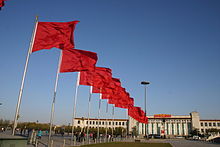Red flag (symbol)


The red flag (also known as the red flag ) is a political identification emblem of social democratic , socialist and communist movements, organizations or states - in particular of the revolutionary left - and a traditional element of international social democracy and the workers' movement . The Aachen revolt of August 30, 1830 is considered the earliest example of the use of the red flag as a symbol of the labor movement . In the GDR it was called the workers flag and was often hoisted in addition to the state flag on public holidays .
The original monochrome red design from the 19th century, as a political signal to the red cap of the Jacobins during the French Revolution back and from there as a banner of the labor movement about the Aachen riots of 30 August 1830 and the German revolution of March 1848 its found further use, differentiated itself especially in the 20th century through the combination with specific coats of arms or symbols. Red flags can be found worldwide as the basis of state flags of socialist states and as party flags of social democratic, socialist and communist parties as well as left revolutionary movements, but also with the NSDAP, which was banned in 1945 .
It is quoted in many workers ' songs as a uniform symbol of identification for worldwide workers ' movements . Well-known examples of this are Bandiera rossa , The red flag or I carry a flag (and this flag is red) . The text of the song of the British Labor Party ( The people's flag is deepest red ) is sung to the melody of the German Christmas carol O Tannenbaum .
Examples
- Flag examples
Flag of the Soviet Union
Flag of Vietnam
Red Army flag
Flag of the CPC
Red Brigades flag
Flag of the People's Republic of the Congo
Flag of the Democratic Republic of Afghanistan
Other meanings of red flags
The red flag has a meaning
- on bathing beaches for the marking of a bathing ban
- in motorsport for interrupting or breaking off training or racing
- in the flag alphabet of shipping as the earlier quarantine flag and today as B = Bravo for "I am loading / unloading / transporting dangerous goods."
- in regatta sailing as a protest flag
- as a red / white diver flag as a warning and protection flag for divers
- in military exercises for sharp shooting, as opposed to practice ammunition
literature
- Rolf Wilhelm Brednich, Rolf Wilhelm Brednich, Heinz Schmitt, Heinz Schmitt (Hrsg.): Symbols. On the meaning of signs in culture, Waxmann Verlag, Münster 1997, ISBN 3-89325-550-8 .
- Leo Uhen: Investigations into groups and associations. Volume 1, Group consciousness and informal group formation among German workers in the century of industrialization, Duncker & Humblot, Berlin 1964.
- Hugo Preuss: Collected writings. Fourth volume, Politics and Constitution in the Weimar Republic, Verlag Mohr Siebeck, Tübingen 2008, ISBN 978-3-16-149519-9 .
See also
- Die Rote Fahne , journalistic organ of the Spartakusbund from 1918
- Red star , often a symbol for the socialist or communist worldview
- Hammer and sickle , symbols for work in industry and agriculture
- Black flag , often a symbol of anarchist movements
- Red Flag Canal or Hongqi Canal in China
- Order of the Red Star , was a Soviet military award
- Order "Red Flag of Labor" , former Bulgarian order
Web links
- Black flag symbol (accessed May 27, 2016)
Individual evidence
- ^ The color of workers , website from May 1, 2013 in the portal farbimpulse.de , accessed on February 26, 2017






